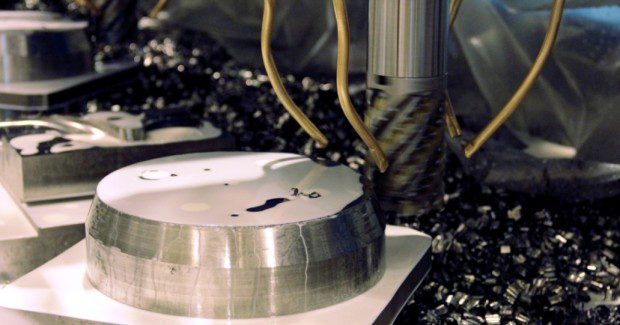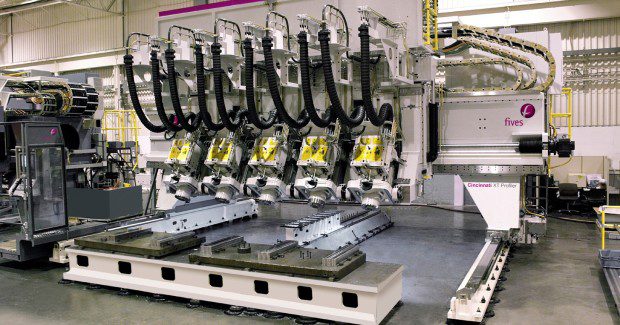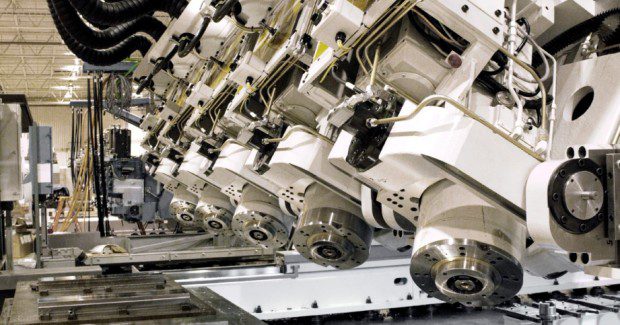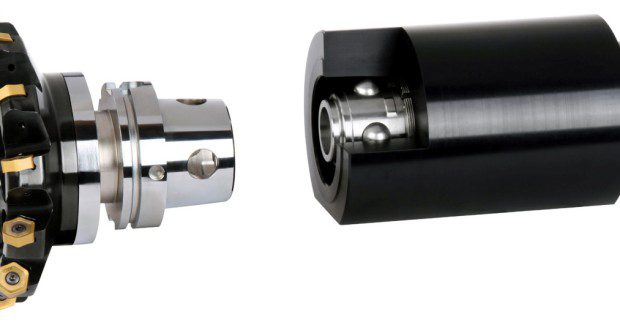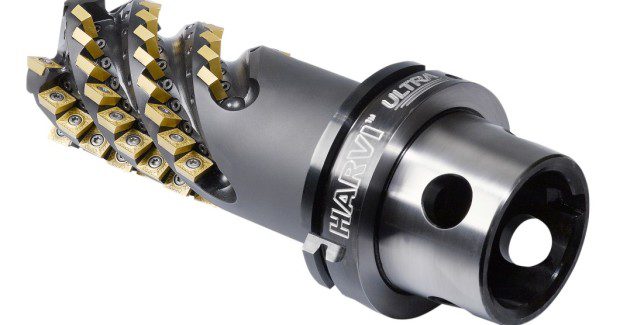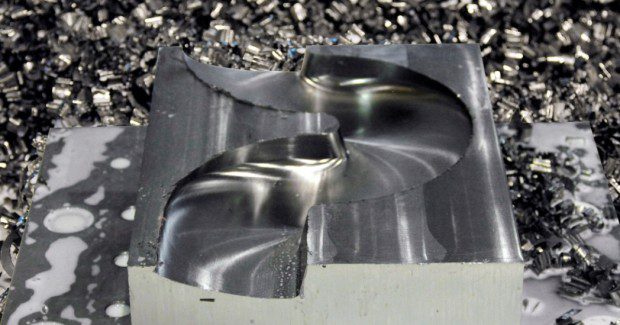How to Win at Titanium Machining
Machine builder Fives Cincinnati discovers how an innovative spindle connection key can achieve new levels of metal removal on industry-leading “super-profiler” operations.
Posted: September 7, 2015
Machine builder Fives Cincinnati finds Kennametal´s KM4XTM spindle connection key to achieving new levels of metal removal on industry-leading “super-profilers.” The Fives Cincinnati XT profiler with five spindles for titanium milling.
What does production superiority mean to aircraft manufacturers? In a word: billions. In the land of the giants, U.S.-based Boeing beat European rival Airbus in net new orders and deliveries in the first quarter of 2015. While the first quarter is the traditionally slow quarter for new orders, it is deliveries that generate the most revenue, and Boeing handed over a record number of jets for the period. For manufacturers of all sizes and types of aircraft, and their entire supply chain of components and parts suppliers working in difficult-to-machine materials, production delays can mean order cancellations, and cancellations can mean shifts to better-equipped builders.
One technology provider that knows this better than most is Fives Cincinnati (Hebron, KY), whose Hebron plant produces Cincinnati machining centers, composites fiber-placement systems, and multi-spindle Cincinnati profilers. With over 650 profilers in the field all over the world, there isn´t a commercial aircraft flying that hasn´t been touched by a Cincinnati profiler, the company says.
Available in three-spindle and five-spindle gantry configurations, the latest generation of these powerful giants, the Cincinnati XTi Profiler, is impressive on many scales. Designed for manufacturers that process multiple materials, 7,000 rpm spindles can cut aluminum and steel and high-torque (2,523 Nm) spindles are available for processing titanium and other hard alloys. Called “the only multi-spindle platform available for titanium roughing,” company literature states the XT sets the MRR (metal-removal rate) record for machining titanium at more than 100 cu ipm. These massive machines, with 4,267 mm of X-axis travel (expandable in increments of 3,658 mm), 3,683 mm in Y-axis, and 711 mm in Z-axis, now are setting new records with optional KM4X100 spindle connections from Kennametal Inc. (Latrobe, PA).
FROM WEAKEST LINK TO STRONGEST FEATURE
Whether profiling on large gantry machines or milling on smaller machining centers, processing tough material like titanium is a constant challenge. Machining hard alloys while adding the pressure of improving production efficiencies means maximizing metal removal in the face of low cutting speeds and significant cutting forces. Machine tool builders like Fives have responded with specialty milling and profiling centers that feature improved stiffness and damping on spindles and sizable machine structures, all to minimize undesirable vibrations that deteriorate part quality, throughput, and tool life. Although these advances have added to greater productivity, the weakest point historically has been the spindle connection.
The tool-spindle connection, the “handshake” between the machine tool and the cutting tool, determines how much material the machine can remove on a given operation. This is because this interface must withstand high loads and yet maintain its rigidity until tool deflection is too high or the onset of chatter is reached. Spindles may be able to transmit a considerable amount of torque, but cutting forces also generate bending moments that will exceed the interface´s limits prior to reaching torque limits. This becomes obvious in end-milling applications, where projection lengths are typically greater — the limiting factor is the spindle interface´s bending capacity. As an example, an indexable helical cutter with 250 mm (9.84 in) projection from spindle face, 80 mm (3.15 in) diameter generates 4,620 Nm (3,407.5 ft-lb) of bending moment and less than 900 Nm (663.8 ft-lb) of torque when removing 360 cm3/min of Ti6Al4V at RDOC of 12.7 mm and an ADOC of 63.5 mm.
By combining high clamping force and optimized interference levels, Kennametal´s next-generation spindle connection KM4X provides a robust connection, extremely high stiffness, and bending load capacity. For titanium processors, this means greatly improved performance in machining high-strength alloys and other materials, enabling extremely high metal removal rates and more completed parts per day.
ADDS MORE TO MACHINE DESIGN
Together with Kennametal senior account manager Mike Malott, Fives Cincinnati applications engineer Robert Snodgrass began evaluating KM4X approximately four years ago. “The engineering is impressive — it definitely allowed us to start thinking that there´s more to machine design, that a stiffer spindle helps meet customer demand for more effective metal cutting and increased throughput.”
“Remember, typical aero structure components start out as forgings with much of the material being removed to achieve finished part specifications,” says Kennametal vice president Mark Huston. “The ‘buy-to-fly’ ratio — the weight you buy in raw material vs. the weight that flies in finished form can be 4:1, 8:1 or more, depending on the component.”
First-generation Cincinnati profilers achieved an MRR of 4 cu ipm in titanium, due to machine structure and tool-spindle connection limitations. With the XT-generation of Cincinnati profilers and face-contact HSK 125 spindle connections, the MRR increased to 50 cu ipm. With the KM4X100, the MRR doubled to 100 cu ipm. “Even at a 100 cu ipm, our benchmark testing for the XT profilers using the KM4X were well below the machine´s theoretical limits for bending moment resistance,” adds Snodgrass. He noted that previous-generation tests employed large CAT60 taper toolholders that, when compared to 50 taper versions are like driving a tank versus an SUV. The KM4X achieved double the metal removal rates versus the 60 taper toolholder. Compared to CAT50, HSK100, or KM4X100 the CAT60 is almost twice the weight.
“This changes spindle and machine design a ton,” says Ken Wichman, Fives Cincinnati product manager. “Many gantry machines have manual tool exchange even though automatic tool exchange/storage is available. The enhanced bending moment resistance of the KM4X allows lighter tooling when compared to a CAT or HSK tool with an equivalent bending moment resistance. Ergonomically, this is a huge benefit to the operator. For customers choosing automatic tool exchange/storage, the smaller KM4X can accommodate more tools in a given footprint.”
“We pride ourselves in keeping customers productive,” adds Fives Cincinnati vice president Mark Logan. “Not only is a more powerful spindle connection like KM4X changing new machine design, it also can be a significant boost for existing machines in the field. This gives us the chance to offer a notable upgrade in retrofits while still pushing the limits on profiler models to come.”
“The industry needs to set new standards for producing titanium parts at the lowest cost per piece, and the XT Profiler provides that capability and more,” says Chip Storie, Fives Cincinnati executive vice president. “With a massive cross-rail, robust spindle design, dedicated foundation, and high-pressure coolant system, we expect to exceed 100 cu ipm metal removal. This is going to change the way the industry approaches titanium machining.”
ANALYZING THE BOBSLED CUT
Mike Malott, a Kennametal senior account manager, has spent years in the field to where he had been granted “family” status on the Fives Cincinnati production floor. He also has noticed that the Fives “bobsled cut” for establishing cutting-tool performance has been making its way around the industry. “To truly put a new configuration through its paces, we had to develop an extremely challenging test — truly something for which the tool was not intended,” says Snodgrass.
The result was forcing a tool through a titanium workpiece following a deep and continuous curve, similar to a bobsled track. “We wanted to max out penetrating depth and torque in a simultaneous-motion cut, all the time subjecting the machine tool and the spindle/cutting tool to extreme forces in every possible way,” notes Snodgrass.
Experienced titianium processors may wince thinking of the screams that would come from the workpiece prior to either the machine tool or the cutter failing. But as the Fives video above proves, a small mountain of chips from a deep and wide test cut can be processed efficiently at a pleasant hum, even on five separate spindles. The proof is in the performance and further improvements are on the horizon.
With a strong foundation based upon renowned brands such as Cincinnati, Giddings & Lewis, Forest-Liné, Liné Machines and Rouchaud, Fives is recognized as the preeminent provider of outstanding manufacturing solutions which are at the heart of its customers´ performance. Key industrial markets served include aerospace, automotive and truck, heavy equipment, oil and gas, rail, wind energy and general machining.
With manufacturing and support operations strategically located worldwide, Fives and its Metal Cutting & Composites businesses offer comprehensive lines of equipment and technologies including automated assembly, laser welding and cutting, turning, milling, composites processing, software, with the associated support and services (maintenance, spare parts, retrofit, overhauling and upgrading).
Celebrating more than 75 years as an industrial technology leader, Kennametal delivers productivity to customers seeking peak performance in demanding environments. The company provides innovative wear-resistant products, application engineering and services backed by advanced material science, serving customers in 60 countries across diverse sectors of aerospace, earthworks, energy, industrial production, transportation and infrastructure.
With approximately 14,000 employees and nearly $3 billion in sales, the company realizes half of its revenue from outside North America, and 40 percent globally from innovations introduced in the past five years. Kennametal and its foundation invest in technical education, industrial technologies and material science to deliver the promise of progress and economic prosperity to people everywhere.
Fives Cincinnati, 2200 Litton Lane, Hebron, KY 41018, 859-534-4600, Fax: 859-534-499, www.fivesgroup.com.
Kennametal Inc., 1600 Technology Way, Latrobe, PA 15650, 800-446-7738, ftmill.service@kennametal.com, www.kennametal.com.



